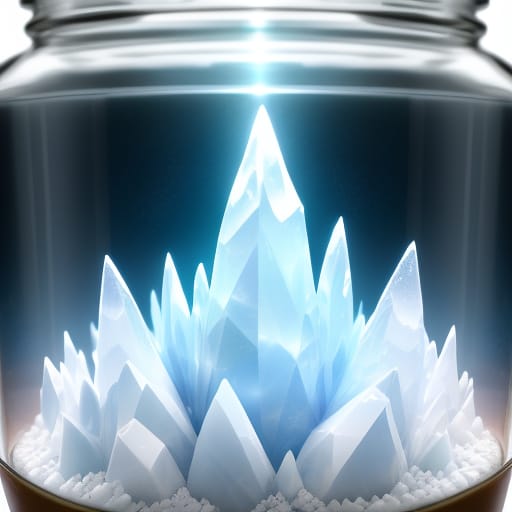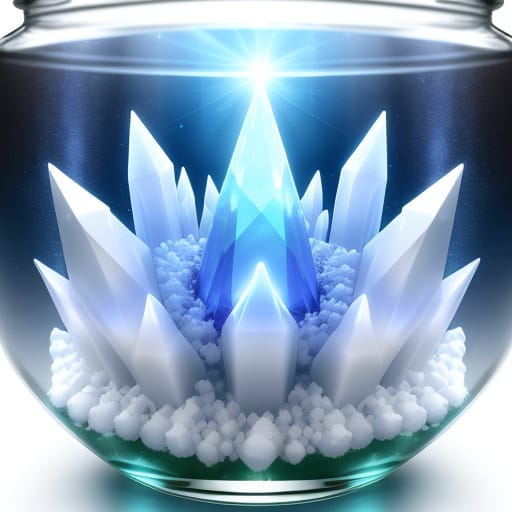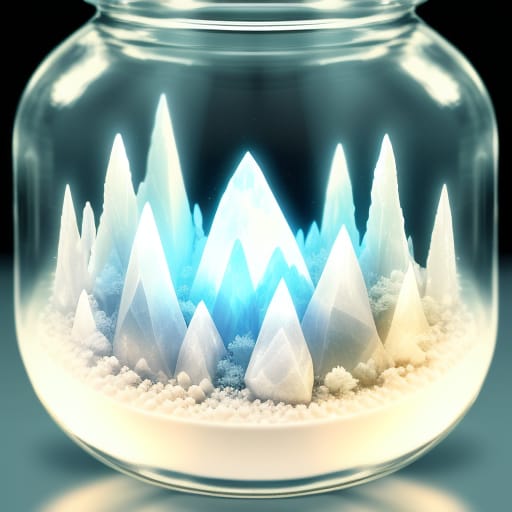Have you ever wanted to grow your own crystals at home? With just a few simple materials, you can easily grow beautiful crystals in your own kitchen! Growing crystals is an enjoyable science experiment that produces stunning results.
In this beginner’s guide, you’ll learn about the 5 easiest crystals to grow at home using household ingredients. We’ll cover everything you need to know to grow picture-perfect crystals every time.

What is Crystal Growth?
Before diving into the easiest crystals to grow, let’s first understand what crystal growth is.
Crystals are solids made up of a repeating, symmetrical pattern of molecules. The molecules arrange themselves in a structured lattice that determines the crystal’s shape.
Crystal growth is the process by which a crystal forms from a solution, melt, vapor, or solid mass. Crystals begin forming when the solution reaches the saturation point, meaning it contains the maximum amount of dissolved solute.
The study of crystal growth dates back to the 17th century. Today, scientists research crystal growth to develop new gemstones, semiconductors, metals, and more.
Growing crystals yourself allows you to witness this incredible natural process firsthand. Plus, it results in beautiful creations you can keep or gift to others!

The 5 Easiest Crystals to Grow at Home
Ready to grow? Here are 5 foolproof crystals you can easily grow with common household ingredients:
1. Rock Candy (Sugar Crystals)
Rock candy is one of the most classic and delicious ways to grow crystals! These large sugar crystals form on strings or sticks suspended in a supersaturated sugar solution.
What You’ll Need:
- 2 cups white sugar
- 1 cup water
- A saucepan
- Wooden skewers or cotton string
- Glass jars or drinking glasses
- Food coloring (optional)
Instructions:
- Boil sugar and water together in a saucepan until the sugar fully dissolves.
- Let the syrupy mixture cool slightly before pouring it into the glass jars.
- Add a few drops of food coloring for colored crystals if desired.
- Tie string or wooden skewers to a pencil or chopstick placed across the top of the jar, with the string/stick dangling in the solution.
- Place jars aside for 3-7 days, until crystals form on the submerged items.
- To harvest, remove items from the solution and allow crystals to air dry.
Tips for Best Results:
- Use filtered water for purity.
- Create a fully saturated solution for optimal crystal growth.
- Put jars in a warm area away from direct sunlight.
- Avoid vibration by keeping jars still.
- Wait at least 5-7 days before disturbing jars.
2. Epsom Salt Crystals
Magnificent clusters of Epsom salt crystals are very easy to grow. Epsom salt (magnesium sulfate) naturally forms fine, prism-shaped crystals as the water evaporates.
What You’ll Need:
- 1-2 cups Epsom salt
- 1 cup very hot water
- Glass jar
- Saucepan
- A wooden skewer or popsicle stick
Instructions:
- Add Epsom salt to a saucepan with hot water and stir until fully dissolved.
- Let the solution cool slightly and then pour it into the glass jar.
- Place a wooden skewer, popsicle stick, or piece of string into the jar, ensuring it touches the bottom.
- Set the jar aside for 2-5 days until crystals fully form on the submerged item.
- To harvest crystals, remove the item from the solution and let the crystals air dry.
Tips for Best Results:
- Use more Epsom salt for thicker, faster crystal growth.
- Try adding food coloring for tinted crystals.
- Keep jars on a flat surface in a warm area.
- Avoid disturbing the jars while crystals are forming.
3. Alum Crystals
Alum is an abundant, inexpensive crystal that is perfect for beginners. When alum powder is dissolved in hot water and cooled, it crystallizes into beautiful, chunky gems.
What You’ll Need:
- 1⁄4 – 1⁄2 cup alum powder
- Glass jar
- Water
- Saucepan
- Pencil or chopstick
Instructions:
- Add 1 cup of water to a saucepan for every 1⁄4 cup of alum powder. Mix and heat until powder dissolves.
- Allow the solution to cool slightly and then pour into the glass jar.
- Place a pencil or chopstick over the mouth of the jar and tie string around the middle, with the string end dangling into the water.
- Set the jar aside for 1-3 days. Crystals will form on the submerged string.
- Remove the string and allow crystals to dry before handling.
Tips for Best Results:
- Use distilled water for purer crystal growth.
- Add more alum powder for faster crystallization.
- Keep jars very still while crystals are forming.
- Drape string so it hangs in the solution but doesn’t touch the bottom.
4. Borax Crystals
Borax, also known as sodium borate, is a popular laundry booster that easily forms dazzling crystals. These geometric crystals have a lovely, sparkly appearance.
What You’ll Need:
- 1-3 cups borax powder
- Saucepan
- Water
- Glass jar
- Pipe cleaner or popsicle stick
Instructions:
- Add 1 cup water to the saucepan for every 1 cup of borax powder. Stir and heat until fully dissolved.
- Allow the solution to cool slightly and pour it into the glass jar.
- Bend the pipe cleaner into an S shape or place a popsicle stick in the jar.
- Leave the jar undisturbed for 3-6 days until crystals fully form.
- Remove the pipe cleaner or stick it carefully to harvest the crystals.
Tips for Best Results:
- Use a 3:1 ratio of borax powder to water.
- Add food coloring for tinted crystals.
- Agitate the solution gently each day.
- Keep jars in a room-temperature area.
- Wait at least 5 days for large crystals.
5. Table Salt Crystals
Plain table salt makes a great crystal for beginners to try. Table salt’s cubic structure results in symmetrical cubes or pyramids.
What You’ll Need:
- 1 cup salt
- 1 cup hot water
- Glass jar
- Saucepan
- Pencil or chopstick
Instructions:
- Add 1 cup water and 1 cup salt to a saucepan. Heat and stir until salt fully dissolves.
- Allow the solution to cool slightly before pouring it into the glass jar.
- Place a pencil or chopstick over the top of the jar. Tie a string around the middle and let the end dangle into the water.
- Set aside the jar for 2-4 days until crystals fully form on the string.
- Carefully remove the string to harvest the crystals.
Tips for Best Results:
- Filter water for best purity.
- Use a wooden skewer for a handle when removing crystals.
- Add food coloring for colored cubes.
- Agitate the jar gently daily.
- Keep the jar away from direct sunlight.
The Science Behind Crystal Growth
Now that you know how to grow crystals, let’s look at the science behind crystal formation.
Crystal growth relies on two key processes – supersaturation and nucleation.
Supersaturation occurs when the concentration of a solute is higher than its solubility limit. This saturated solution causes the solute molecules to gradually form an ordered crystalline structure.
Nucleation is when the first microscopic crystal forms and acts as a seed for further crystalline growth. Spontaneous nucleation occurs in supersaturated solutions.
Once nucleation occurs, crystals will continue growing larger over time through molecular deposition as the solution evaporates.
Other factors like temperature, acidity, and agitation also impact the crystallization process. Understanding these principles allows you to tweak the methods and grow picture-perfect crystals.
Fun Uses for Homegrown Crystals
The crystals you grow will be gorgeous works of art! Here are some ways to use your harvested crystals:
- Jewelry Making – Wire wrap rock candy or borax crystals for stunning pendants!
- Home Decor – Place crystals in glass vases or jars to showcase around your home.
- Science Experiments – Use crystals to demonstrate principles like nucleation or solubility.
- Arts and Crafts – Incorporate crystals into Christmas ornaments, candle holders, or terrariums.
- Gifts – Package your crystals in decorative jars or bottles to give as gifts!
FAQs About Growing Crystals
Can I grow crystals without heat?
Yes, you can grow crystals without heating the solution first. However, heating helps dissolve more solute to create a supersaturated solution that grows crystals faster.
Do crystals stop growing at some point?
Crystal growth slows down and eventually stops once the solution reaches equilibrium, meaning the dissolved and precipitated solute are balanced. Removing the formed crystals allows new ones to keep growing.
What if my crystals won’t form?
If crystals don’t form, try increasing the solute concentration, disturbing or agitating the solution, or changing the temperature. Seeding the solution with a small crystal can also induce crystallization.
Are crystals I grow safe to handle?
Most common crystals like sugar, salt, and alum are safe to handle. However, some crystals like borax can be irritants for sensitive skin. Use caution and wash hands after handling.

Ready, Set, Grow!
That covers the basics of how and why crystals form, plus 5 foolproof crystals you can easily grow at home. The magical process of crystal growth allows you to produce gorgeous, shimmering gems with just simple materials.
Start with one of these beginner-friendly crystals like alum, salt or Epsom salt. Learn the techniques and bask in the wonder of growing your own crystalline structures. You’ll be hooked on this rewarding science experiment and craft in no time!
For more crystal growing projects, in-depth guides, images, and experiments for all ages, check out these helpful resources:
- Illustrated Guide to Crystal Projects from the Smithsonian
- Crystal Recipe Book from Fun Science Gallery
- Tips for Growing Stunning Crystals from Steve Spangler Science
FAQs About Growing Crystals
Can I grow crystals without heat?
Yes, you can grow crystals without heating the solution first. However, heating helps dissolve more solute to create a supersaturated solution that grows crystals faster.
Do crystals stop growing at some point?
Crystal growth slows down and eventually stops once the solution reaches equilibrium, meaning the dissolved and precipitated solute are balanced. Removing the formed crystals allows new ones to keep growing.
What if my crystals won’t form?
If crystals don’t form, try increasing the solute concentration, disturbing or agitating the solution, or changing the temperature. Seeding the solution with a small crystal can also induce crystallization.
How can I make bigger crystals?
Using a higher solute-to-solvent ratio creates a more supersaturated solution that will yield larger crystal growth. Allowing crystals more time to form unattended also results in bigger crystal sizes.
Are crystals I grow safe to handle?
Most common crystals like sugar, salt, and alum are safe to handle. However, some crystals like borax can be irritants for sensitive skin. Use caution and wash hands after handling.
Can I re-grow crystals from harvested crystals?
Yes, you can use harvested crystals as seed crystals to promote crystal growth in a new solution. Simply tie a harvested crystal to a string and submerge it in a fresh saturated solution to continue crystalline growth.